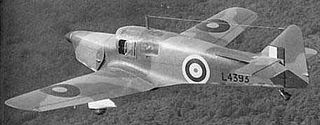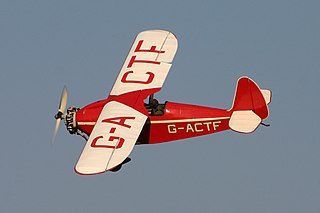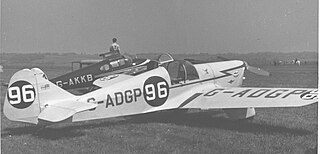
The Ikarus Aero 2 was a piston-engined military trainer aircraft built in Yugoslavia in the years following World War II, although the design pre-dated the war.

The Miles M.16 Mentor was a 1930s British single-engined three-seat monoplane training and communications aircraft built by Miles Aircraft Limited.

The Foster Wikner Wicko was a 1930s British two-seat cabin monoplane built by the Foster Wikner Aircraft Company Limited at Southampton Airport, Hampshire.

The Auster J/1 Autocrat was a 1940s British single-engined three-seat high-wing touring monoplane built by Auster Aircraft Limited at Rearsby, Leicestershire.

The Auster J/5 Autocar was a late 1940s British single-engined four-seat high-wing touring monoplane built by Auster Aircraft Limited at Rearsby, Leicestershire.

The Auster J/5 Aiglet Trainer was a 1950s British single-engined four-seat high-wing training and touring monoplane built by Auster Aircraft Limited at Rearsby, Leicestershire.

The Comper C.L.A.7 Swift is a British 1930s single-seat sporting aircraft produced by Comper Aircraft Company Ltd of Hooton Park, Cheshire.

The Miles M.2 Hawk was a twin-seat light monoplane designed and produced by the British aircraft manufacturer Miles Aircraft Limited during the 1930s. It is the first of the company's aircraft to attain quantity production.

The Miles Hawk Major was a 1930s British two-seat light monoplane, developed by Miles Aircraft from the Miles Hawk in order to take advantage of the new inverted de Havilland Gipsy Major engine. When fitted with the longer Gipsy Six in place of the forward crew member, it was known as the Miles Hawk Speed Six.

The Miles M.3 Falcon is a 1930s British three/four-seat cabin monoplane aircraft designed by Miles Aircraft Limited.

The Miles M.7 Nighthawk was a 1930s British training and communications monoplane designed by Miles Aircraft Limited.

The Elliotts of Newbury EoN or Elliotts EoN A.P.4 was a 1940s British four-seat touring monoplane aircraft built by Elliotts of Newbury.

The Comper Mouse was a 1930s British three-seat cabin monoplane designed by Nicholas Comper, and built by the Comper Aircraft Company at Heston Aerodrome in 1933.

The Parnall 382 was a 1930s British single-engined monoplane trainer aircraft with two open cockpits, designed and developed by Parnall Aircraft Ltd.

The Heston T.1/37 was a 1930s British single-engined monoplane military trainer aircraft with two open cockpits, designed and developed by Heston Aircraft Company Ltd. It was not accepted for service.
The CLW Curlew was a two-seat, single-engined training aircraft built partly to demonstrate a new wing structure. It flew successfully in the UK in 1936, but the company went bankrupt and only one Curlew flew.
The British Aircraft Cupid was a two-seat, single-engined monoplane, a smaller version of the B.A. Eagle designed for touring and training. Only one was built.

The Comper Streak was a single-engined, single-seat racing monoplane built in the UK in the mid-1930s. It was not successful as a racer and only one was produced.

The Auster 6A Tugmaster was a British high-wing monoplane glider tug converted from surplus former military Auster AOP.6s.

The Miles Hawk Speed Six was a 1930s British two-seat light monoplane, developed by Miles Aircraft from the Miles Hawk Major by fitting the longer and more powerful Gipsy Six engine and removing the forward crew member.


















